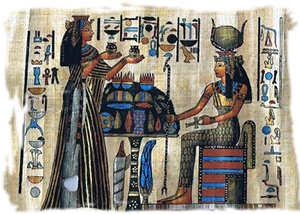
The value of natural plant oils has been recognized for more than 6,000 years, for their healing, cleansing, preservative and mood-enhancing properties, as well as for the sheer pleasure of their fragrances. Today, these properties are being rediscovered as we look to the wisdom of past eras and civilizations to restore the balance that has been lost in modern-day life. Stress, pollution, unhealthy diet, hectic but sedentary lifestyles – all these factors have adverse effects on our bodies and spirits. The art of aromatherapy harnesses the potent pure essences of aromatic plants, flowers and resins, to work on the most powerful of senses – smell and touch – to restore the harmony of body and mind.
Secrets of the Oils Discovered
The origins of aromatherapy can be traced through the religious, medical and social practices of all the major civilizations. It is likely that the Chinese were the first to discover the remarkable medicinal powers of plants around 4500 BC. However, it is the Egyptians who must take the credit for recognizing and fully exploiting the physical and spiritual properties of aromatic essences. From hieroglyphs and paintings we know that aromatic preparations were used as offerings to the gods. Furthermore, the natural antiseptic and antibacterial properties of essential oils and resins, particularly cedarwood and frankincense, made them ideal for the purpose of preserving corpses in preparation for the next world. The discovery of remarkably well-preserved mummies up to 5,000 years after their preparation is a tribute to the embalmer’s art.
By around 3000 BC priests who had been using the oils in religious ceremonies and embalming rites became aware of the usefulness of their properties for the living, too. Closely guarding their secrets, they became the healers of their time, mixing and prescribing “magical” medicinal potions. Use of essential oils gradually permeated all levels of society as cosmetics and perfumes became widespread.
From Hippocrates we know the Greeks had some awareness of the therapeutic properties of the oils and their value as sedatives and stimulants was generally recognized. The Greeks and Romans used aromatics widely in rituals and ceremonies and the oils played an important role in the rise in popularity of baths and massage and body-culture generally. However, with the fall of the Roman Empire the use of essential oils died out in Europe.
The art flourished elsewhere, though, particularly in Arabia, where Avicenna first distilled rose essence in around AD1000. Arabia became the world’s centre for production of perfume, importing raw materials from Egypt, India, Tibet and China, and trading their products internationally.
With the Crusaders the art of perfumery was reintroduced to Europe around the twelfth century. Records show that aromatics were used a protection against the plague and the lower incidence of death among perfumiers suggests they were to some degree effective. The fifteenth century saw the rise of the great European perfumiers, and their wares were widely used to disguise body smells and ward off sickness. By the seventeenth century the aphrodisiac properties were well recognized, and with the work of herbalists, such as Culpeper, the therapeutic properties also started to be recorded, laying the foundation for modern aromatherapy.
The Modern Renaissance
The term “Aromatherapie” was first used in 1928 by a French chemist, Rene-Maurice Gattefosse, to describe the therapeutic action of aromatic plant essences. In his perfume lab, he burned his hand badly and quickly dropped it in the nearest liquid, lavender oil. He was amazed at the speed of healing and the lack of scarring. He began to research the antiseptic and antibiotic properties of essential oils. His work was taken up by Dr Jean Valnet who found the essences’ remarkable regenerative and antiseptic properties effective for healing the wounds of World War II soldiers. After the war, he continued to use essential oils in his practice.
In 1964, he published his research and began teaching other doctors about the healing properties of essential oils. Robert Tisserand translated Valnet's work and introduced aromatherapy to the mainstream.
The application of aromatherapy to beauty therapy and health care was pioneered by Marguerite Maury in her influential book, The Secret of Life and Youth. She also developed the method of applying the oils through massage.
Today there is a world-wide revival in the art of aromatherapy and contemporary research is beginning to understand the scientific foundations of the oil’s properties and applications, discovered by trial and error over thousands of years.
Source: Yoga, Tai Chi, Massage, Therapies & Healing Remedies by Mark Evans B Phil., FNIMH, published by Hermes House, 2002
If you appreciate the information provided,
please help keep this website running. Blessings!
© 2008-2025 aromaworx.ca. All rights reserved.

